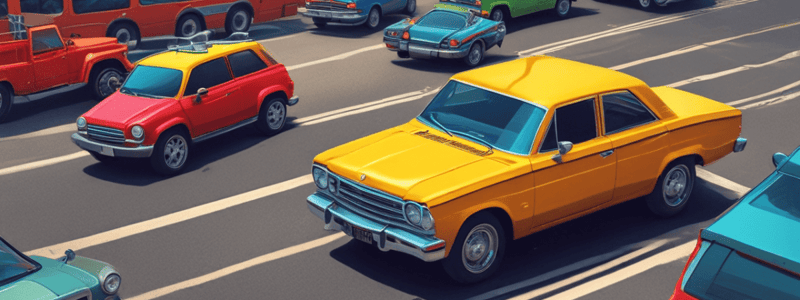Podcast
Questions and Answers
When approaching an intersection with a stop sign, where must the driver stop?
When approaching an intersection with a stop sign, where must the driver stop?
What must the driver do after stopping at an intersection with a stop sign?
What must the driver do after stopping at an intersection with a stop sign?
At an uncontrolled 'T' intersection, who must yield the right-of-way?
At an uncontrolled 'T' intersection, who must yield the right-of-way?
What must a driver do when approaching an intersection with a 'Yield Right-of-Way' sign?
What must a driver do when approaching an intersection with a 'Yield Right-of-Way' sign?
Signup and view all the answers
When must a driver stop at an intersection with a 'Yield Right-of-Way' sign?
When must a driver stop at an intersection with a 'Yield Right-of-Way' sign?
Signup and view all the answers
What is the main purpose of a 'Yield Right-of-Way' sign?
What is the main purpose of a 'Yield Right-of-Way' sign?
Signup and view all the answers
Which of the following is NOT a requirement for drivers approaching an intersection with a stop sign?
Which of the following is NOT a requirement for drivers approaching an intersection with a stop sign?
Signup and view all the answers
How should a driver approach an uncontrolled 'T' intersection?
How should a driver approach an uncontrolled 'T' intersection?
Signup and view all the answers
What is the main difference between a stop sign and a 'Yield Right-of-Way' sign?
What is the main difference between a stop sign and a 'Yield Right-of-Way' sign?
Signup and view all the answers
What is the primary purpose of the text provided?
What is the primary purpose of the text provided?
Signup and view all the answers
Study Notes
Stop Signs and Intersections
- When approaching an intersection with a stop sign, the driver must stop before the white line or, if there is no line, at the point where the driver can see oncoming traffic.
- After stopping at an intersection with a stop sign, the driver must yield to pedestrians and other vehicles already in the intersection, and then proceed with caution.
Uncontrolled 'T' Intersections
- At an uncontrolled 'T' intersection, the driver on the terminating road must yield the right-of-way to traffic on the continuous road.
'Yield Right-of-Way' Signs
- When approaching an intersection with a 'Yield Right-of-Way' sign, the driver must slow down or stop, if necessary, to let other traffic or pedestrians go first.
- A driver must stop at an intersection with a 'Yield Right-of-Way' sign if it is necessary to avoid a collision or to let others go first.
- The main purpose of a 'Yield Right-of-Way' sign is to assign right-of-way to other traffic or pedestrians.
- The main difference between a stop sign and a 'Yield Right-of-Way' sign is that a stop sign always requires a complete stop, while a 'Yield Right-of-Way' sign requires yielding to others but not always stopping.
General Rules
- At an uncontrolled 'T' intersection, the driver should approach slowly and cautiously, looking for traffic on the continuous road.
- The primary purpose of the text is to provide rules and guidelines for drivers approaching intersections with stop signs or 'Yield Right-of-Way' signs.
Studying That Suits You
Use AI to generate personalized quizzes and flashcards to suit your learning preferences.
Description
Test your knowledge on the rules that vehicles must follow when approaching intersections with stop signs. Learn about stopping at stop lines, crosswalks, and points where the driver has visibility of approaching traffic.




